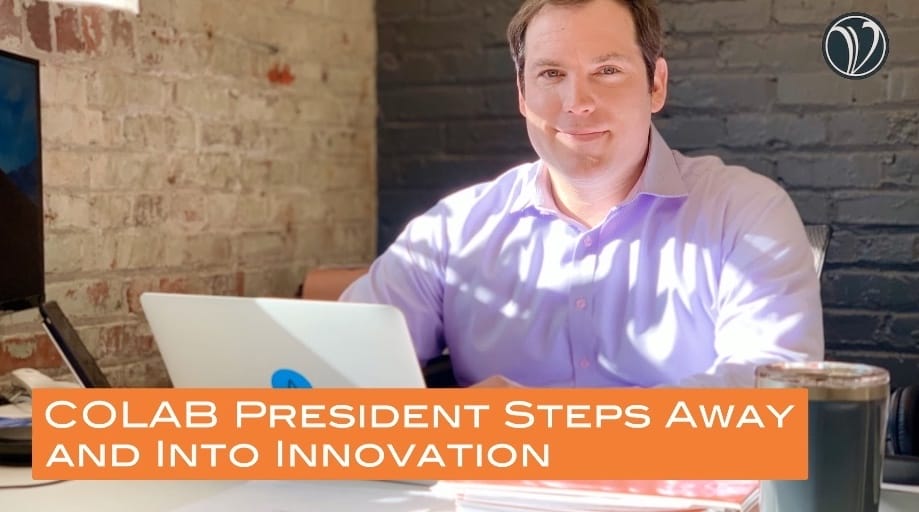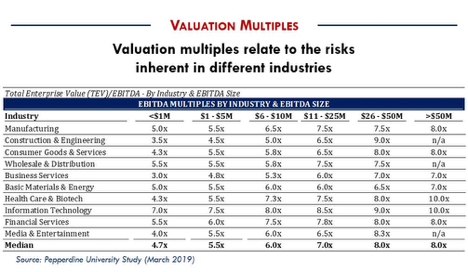Follow the Leaders
Top 7 Posts of 2019
Each month we work hard to bring you content of interest to you and news you can use. From tactical takeaways to strategic planning to CEO profiles that intrigue, here are the most-read stories of the year.
What kind of content would you like to see posted to vaceos.org? More CEOs profiles? More business tips? Is there a specific topic you would like covered? Please, let us know!
MOST-READ STORY OF 2019:
COLAB President Steps Away and Into Innovation (Video+)(#1)
For Eddie O’Leary, president of COLAB, one of the best business decisions he’s ever made was to step away from it.
Here’s how the other most-viewed posts faired.
TOP 7 COUNTDOWN: 2019 VACEOs.ORG STORIES OF THE YEAR

(Video+)(#7)
JJ White opens up from his podcast studio about his business and his plans to shape the Council during his tenure as Chair.

by Warren Whitney (VACEOs Sponsor)(#6)
Here are the 6 key questions to ask when assessing your MSP relationships or when evaluating a new one.

by Partner MD (VACEOs Sponsor)(#5)
Running a business can be extremely stressful. Here are 3 steps to help you manage the unique stressors you face.

of Charles E. McCabe Leadership Award (#4)
We are pleased to announce that Arlene Lee, President of R.E. Lee Companies (Charlottesville) has been awarded the Charles E. McCabe Leadership Award.
How to Calculate the Value of Your Business
by Transact Capital (VACEOs Sponsor)(#3)
A company’s worth is impacted by any decisions that boost its EBITDA or reduces perceived risk to the buyer. Here’s how to calculate your earnings.
Fueled for Success: Q&A with Tiger Fuel President Gordon Sutton
(Video+)(#2)
With an employee count topping 270, Tiger Fuel is a successful, large-scale operation. What fuels this company’s success? President Gordon Sutton shares all.

For Eddie O’Leary, president of COLAB, one of the best business decisions he’s ever made was to step away from it.
Tips for Year-End Planning from a Fractional CFO
Do you take your fiscal year-end preparation in stride, or do you dread it? Whether your year end is December 31st, June 30th, or any other date, most likely you need to make sure your financial statements are ready for tax returns and, possibly, for auditors, bankers, and/or investors. The best way to take it all in stride is to ensure you take the proper steps monthly and quarterly for minimal work at the end of your fiscal year.
Here are the critical steps one should take throughout the year to ensure a smooth and painless fiscal year end.
MONTHLY:
- First and foremost, perform a good review each month of the balance sheet and profit & loss statement while information is still fresh in your mind.
- Run comparisons to budget and comparisons to prior year to identify variances that do not look right.
- Review all general ledger activity.
- Reconcile all the balance sheet accounts monthly, which will minimize year end corrections.
- On monthly bank reconciliations, ensure there are no checks over 60-90 days that have not cleared the bank. If there are, start calling vendors to see if they received check and re-issue as necessary.
- Run an Accounts Payable detailed listing and make sure all bills are current. Sometimes you have re-issued a payment for a lost check only to realize at year end that you haven’t taken care of the first payment that was lost or voided.
- Review Accounts Receivable aging and take follow-up actions accordingly.
- Record Investment activity monthly.
- Make copies of any capital purchases and consolidate in either a capital expense profit & loss account or in a category of fixed assets on your balance sheet.
QUARTERLY:
- Reconcile your wages paid to the 941 Employer’s tax form filed. This will ensure that all taxable wages paid have been reflected properly on the 941. If there are adjustments to be made, ensure you can correct before the annual W-2 Wage and Tax Statement are filed for employees.
- Ensure that board and committee minutes required for annual audits are approved and filed.
ANNUALLY:
- Make a reminder to review payroll adjustments necessary to be added to employees W-2’s for other taxable income.
- Review listing of 1099 eligible vendors and ensure you have proper federal identification numbers.
- If you are being audited by an outside firm, request a listing of documents needed in advance of field work.
- If you need an annual inventory count, schedule the date and publish procedures.
- Start a new filing system for the next fiscal year during the 2nd half of your last fiscal month, so that records can be kept separate right from the beginning.
- Review your fixed asset listing for any items that you have disposed of during the year.
** Above all, ensure that you reconcile your bank statement monthly. **
A key point is to take corrective action while transactions are still clear in your mind. It’s much harder to figure out adjustments if the details are fuzzy.

Jill Swinger is a director of Warren Whitney and is primarily engaged by organizations requiring financial management analysis. Jill offers a well-rounded business background and brings more than 30 years experience in both public accounting and private industry finance. Learn more.
Editors note: Image and content provided by Warren Whitney. This post article was originally posted here. Warren Whitney is a Sponsor of Virginia Council of CEOs.
Beyond Passwords: 4 Ways to Stay Ahead of Cyber Crime
Think cyber criminals are most interested in targeting big business? Think again. The U.S. Small Business Association (SBA) reports that 43% of the nearly 42,000 online security incidents that took place around the world last year targeted small businesses.
No matter how skeptical you may be of the stats heard around the world, data breaches can lead to stolen customer data and financial losses, and can severely damage brands. Businesses can be crippled for days by a breach – some taken down altogether. It’s undoubtedly a growing problem for businesses of all sizes.
Data security is Sklar Technology Partners’ primary mission. President Randy Sklar reports that his business has grown steadily busier in the past three years. Fortunately, innovation and proprietary services have kept his clients ahead of the bad guys – for now.
What are some of the biggest threats that small and mid-sized businesses face? “Ransomware remains a major threat, and wire fraud is something we hear about, as well,” says Sklar. “The biggest threat I hear about is credential stuffing. A local salon just lost $12,000 in a payroll heist, and [the owner] was using breached passwords for her ADP and email accounts. The cyber crook tried to get $80,000 and made off with $12,000.”
REGULAR PASSWORD CHANGES ARE NOT ENOUGH
We all know our passwords should be a complicated jumble of characters and numbers, and that we should update them and our business software regularly. Still, if you’re concentrating only on those actions, you could be leaving your business exposed to hackers. One of your best defenses is a solid offense. Here are four ways to get started.
STEP 1) KNOW WHERE YOU’RE VULNERABLE: PERFORM (REGULAR) RISK ASSESSMENTS
A formal assessment by a professional will help you identify your vulnerabilities and the conditions required to exploit them. A sound assessment will help you understand the likelihood that an attack would succeed and the potential impact it would have on your business. Sklar suggests performing a risk assessment annually or if any major changes happen to your digital assets, like implementing a new application.
“A typical assessment focuses on technology issues and the assessment should be solely focused on the asset. In this case, digital asset. And the report should be an easy-to-read graph outlining the impact vs. likelihood an asset will be compromised or lost,” says Sklar, who is a member of Virginia Council of CEOs. Sklar Technologies offers a good risk assessment discover tool here.
STEP 2) CREATE A FORMAL CYBERSECURITY PLAN: HERE’S A RESOURCE
You know where you’re vulnerable. Now formulate a plan that outlines the procedures and policies your organization will follow to prevent and recover from a data breach. Not sure where to begin? We found a good customizable cybersecurity planning tool designed by the FCC. Or, better yet, contact a trusted local resource for plan set up and training.
STEP 3) HAVE A SOUND DETECTION SYSTEM IN PLACE
We’re often focused on keeping hackers out via firewalls, antivirus software, etc., but we come up short when it comes to breach detection. “Nothing is secure without detection,” says Sklar. “Just like at home, you want to have alarms, motion lights and barking dogs to detect the intruder. Make sure the person or organization in charge of your cybersecurity is comfortable in their ability to detect and quickly respond to a breach.”
STEP 4) MAKE EMPLOYEE EDUCATION & TRAINING A BUSINESS PRIORITY
A key component of any business’ cybersecurity defense system is to make cybersecurity a priority for leadership and staff. Show your commitment. Keep it short, simple, and fun! For example: Why not a game show or competition? Avoid boring videos and lectures, they are ineffective. Make it a team building opportunity, if you can. Cover topics like:
- Your password policy and why it’s important
- Your software policy and update process and why they’re important
- Cybersecurity best practices
- Your plan of action, should your business or customer data become exposed
October is Cyber Security Month! Don’t let a cyber crime cripple your business or, worse, bring it down. Make a serious commitment to assessment, a comprehensive detection system and plan, and ongoing education.
Additional resources used for this article: “3 Simple Things to Protect Against Cyberattacks” by Anita Campbell.
How to Know If a Fractional CFO Is Right for Your Business
You are the CEO of a growing business. Do you need to:
- Spend more time in areas of the business where you add the most value?
- Maximize cash?
- Add an operational finance perspective to your team?
- Update your strategic plan?
- Raise capital to grow your business?
- Add a trusted advisor to your executive team?
- Develop an exit strategy for your business?
- If you answered yes to one or more of these questions, it could be time to get an experienced CFO on your team.
You may have thought about hiring a full-time CFO but held off given cost. Or perhaps you were concerned that you do not have enough work to keep a full-time CFO challenged. There is an alternative: You can engage an experienced CFO on a part-time or project basis.
By hiring a fractional CFO, you’re instantly gaining access to all the knowledge, experience and lessons learned by this CFO over a career. All at a significant cost savings to you.
Jay Nathanson, COO of Image Group, found it to be “a very, efficient way to use expertise.” Adding, “It really became a great opportunity for me to be able to grow the business without making the investments of full-time people.”
Building on my 35 years of experience, including serving as a full-time CFO for six companies and as a fractional CFO for others, I share several scenarios which describe situations where a fractional CFO might be able to help you.
YOU KNOW YOU NEED A FRACTIONAL CFO WHEN… (7 SCENARIOS)
Scenario #1: You Need to Spend More Time in Areas Where You Add the Most Value
If you’re spending more time in planning and forecasting, contract negotiations and interactions with investors, and less time with customers, in strategy development and in other areas where you excel, it’s time to engage a seasoned CFO. This executive will free you up, enabling you to add greater value to the business.
Scenario #2: You Need to Maximize Cash
You understand that cash is king. You need the ability to forecast future performance, staying on top of cash forecasts, debt covenants, receivables and payables. You also need creativity in the use of bank and other kinds of debt. An experienced CFO can help you maximize cash at the lowest cost.
Scenario #3: You Need an Operational Finance Perspective
You are getting accurate historical financial information; however, you are not getting meaningful analysis and insights from such information to drive your business forward. The right CFO will bring significant operational finance experience to the business, enabling you to fully understand historical performance, get the right metrics in place and more.
Scenario #4: You Need to Update Your Strategic Plan
As your business grows, there are many places where you can invest limited resources: sales and marketing, product development, customer success and more. To get the best return requires an understanding of customer issues, customer and product profitability, the competitive landscape and more. An experienced CFO can link financials and strategy, helping develop a plan which will increase your odds of success.
Scenario #5: You Need Capital to Grow Your Business
To execute your plan, you need to invest more in sales and marketing, customer success and new product development. This requires additional capital. Engaging a CFO skilled in raising capital will help you negotiate the best deal, minimizing dilution.
Scenario #6: You Need a Trusted Advisor
As the business grows, you are encountering a range of issues and questions, from personnel (e.g., what incentive program is right?) to tax (e.g., do I have sales or use tax exposure?). You need someone on your team with significant experience across many businesses and circumstances, someone who understands and has been around different C-Suite roles. Engaging an experienced CFO will help you get to the right answer quickly.
Scenario #7: You Need an Exit Strategy
Positioning your business for sale is not cut and dry. If you’re considering a sale in the next few years, now is the time to prepare. To get the most value, you need the advice of a CFO skilled in buying and selling companies.

Bobby Jenkins, Managing Director, Fahrenheit Advisors (Charlottesville), is an accomplished executive with 35 years’ experience and a demonstrated track record in diverse businesses and circumstances. Working with public and private companies, large and small, he has played a key role in increasing equity value for stakeholders. His experience and skills position him well now to add value to Fahrenheit clients, particularly in engagements related to business planning, capital raises, performance management and restructuring.
EDITOR’S NOTE: Image and content provided by Fahrenheit Advisors. This post article was originally posted here. Fahrenheit Advisors is a Sponsor of Virginia Council of CEOs.
How to Calculate the Value of Your Business
Whenever a member of our team wraps a speaking engagement, after the public Q&A session, the CEO of a company invariably pulls us aside and in a half-whisper asks, “How do I know what my company’s worth?” This is usually hotly followed by, “What can I do to increase the value? When is the best time to sell, and how long will I stay on after I sell?”
There are entire books devoted to answering these questions, but let’s see what we can do in a few paragraphs. Let’s start with this:
WHAT’S MY COMPANY WORTH?
All merger & acquisition (“M&A”) transactions are valued on two fundamentals – the return a potential investment can yield and the perceived risk of getting that return. It doesn’t need to be more complex than that. Simply put, M&A makes sense to an acquirer when the cost (and risks) of securing additional revenue outweighs the cost of building the business organically.
Buyers initially focus on the potential earnings from an acquisition target. So, what exactly are earnings? The most common measure is EBITDA – Earnings Before Interest, Taxes, Depreciation, and Amortization. Because a buyer may have a different tax rate and a different capital structure, they exclude the target’s unique tax rate and interest payments. Similarly, depreciation and amortization are non-cash expenses, and companies may have varying accounting policies regarding how items are depreciated or amortized, so buyers typically look at earnings before these non-cash expenses. Thus, EBITDA is an attempt to measure cash flow from the business on an apples-to-apples basis.
In order to calculate EBITDA, start with net income before corporate taxes, add back interest expense, depreciation, and amortization, if any, to arrive at EBITDA. After all this work, this is a great place to stop, take a break, and get a cup of coffee.
ADJUSTING YOUR EBITDA
Many CEOs of privately held companies run expenses through the business that would not necessarily be incurred by a new buyer. These might include family members on the payroll, the one-time legal expense for an issue the company had last year, or the 30-foot Wellcraft boat the company uses on weekends as a “research vessel”. There are many others, and it takes a thorough review of your financials to prune out these unusual or non-operating expenses.
Because of these, we want to calculate “Adjusted EBITDA”. Starting with your financial statement EBITDA, add these extraneous expenses back. Be prepared to justify these addbacks because buyers will always be suspect that the expense was really necessary to generate cashflow.
The next part appears relatively simple, but in reality, has complex math behind it. Look at the table below and multiply your Adjusted EBITDA by the respective EBITDA multiple given your industry and EBITDA size. For example, if you own a healthcare company with $1 million in EBITDA, multiply it by 5.5x and the initial valuation is $5.5 million. This is BEFORE the multiple is handicapped for perceived risks.
But what is this magical table? It is a summary of implied valuation multiples based on a large survey of actual sale transactions (“comps”), in this case compiled by Pepperdine University and published in the spring of 2019. The business school conducts a survey each year of investment banks, CPAs, and various intermediaries involved in the sale of companies.
A complete or formal valuation will include other analysis and computations, but this provides a thumbnail value range for your company. Comparing changes over multiple years also reveals some trends. Higher growth industries such as information technology and biotech have higher multiples while low growth industries such as construction have lower multiples. In general, higher growth gets a higher valuation. Since buyers are paying for future cash flow and growth results in higher profits, it makes sense they would pay more.
Notice how the values increase from the first column to the third column, In general, the larger the company, the higher the valuation. Larger companies tend to have more “quality” earnings, such as: complete management teams, better accounting systems, and more thorough business processes. In other words, there is less perceived risk that some unforeseen negative event will threaten the cashflow. Similarly, a smaller company may be dependent on one or two key employees or customers, and if something happens to one of them, earnings will likely suffer.
In addition to projecting earnings, buyers assess the risks to the earning and those risks decrease the valuation. Some of these risks are:
- Customer concentration as a percentage of sales
- Key personnel, such as a key executive or CEO-owner who is critical to the performance of the company. This also includes important personnel that have not been secured with employment agreements.
- Poor accounting and record keeping
- Risk of technical obsolescence
- High on-going investment in equipment
CEOs need to continually work to reduce the risks in their companies. This will, in turn, preserve if not improve the multiple applied to the Adjusted EBITDA number.
When it’s distilled down to its essence, a company’s worth is impacted by any decisions that boost its EBITDA or reduces perceived risk to the buyer; all within the purview of the CEO and not really so mysterious.
Patrick Morin is currently a Partner at Transact Capital. He joined the firm as Managing Director in 2012. Patrick brings with him a wealth of experience in capital raising, deal-making, strategic advisory to CEOs, marketing and revenue generation, along with investment banking and business ownership. As a prominent speaker to industry groups and business, Patrick is well connected to many well-known business leaders throughout the U.S.
EDITOR’S NOTE: Content provided by Transact Capital. Transact Capital is a Sponsor of Virginia Council of CEOs.















Recent Comments